
Schinia, commonly called flower moths, is a large genus of moths belonging to the family Noctuidae. The genus has a Holarctic distribution with the vast majority of species being found in North America, many with a very restricted range and larval food plant.

Acronicta tritona, the Triton dagger moth, is a moth of the family Noctuidae. The species was first described by Jacob Hübner in 1818. It is found in eastern North America, from Nova Scotia west to north-eastern Alberta, south to Florida and Texas, and west to Oregon.

Alypia is a genus of moths in the family Noctuidae.

Chytolita is a monotypic litter moth genus of the family Erebidae erected by Augustus Radcliffe Grote in 1873. Its only species, Chytolita morbidalis, the morbid owlet moth or morbid owlet, was first described by Achille Guenée in 1854. It is found in large parts of North America, from coast to coast in the north and south to North Carolina, Texas and Florida in the west. The habitat consists of deciduous woods and edges.

Alypia octomaculata, the eight-spotted forester, is a moth of the family Noctuidae first described by Johan Christian Fabricius in 1775. It is native to Canada, but can be found today throughout Northern America, ranging between Nova Scotia to Florida and South Dakota to Texas. Their habitats being rather specific, they make home where wooded areas meet open fields.

Euxoa medialis, the median-banded dart, is a moth of the family Noctuidae. The species was first described by Smith in 1888. It is found in North America from southern Manitoba and central Wisconsin, west to southwest Alberta and California; north to southern Alberta and south to south-central Mexico.
Acronicta vulpina, the vulpina dagger moth or miller dagger moth, is a moth of the family Noctuidae. The species was first described by Augustus Radcliffe Grote in 1883. It is found in North America from New York and Newfoundland west to central British Columbia, south to Colorado.

Alypia ridingsii, the mountain forester or Ridings' forester, is a moth of the family Noctuidae. The species was first described by Augustus Radcliffe Grote in 1864. It is found in North America as far east as the eastern edge of the Rocky Mountains in Colorado. It is also found in Arizona, Utah, all of California and northward into Oregon, Idaho, Washington, British Columbia and Alaska
Alypia wittfeldii, or Wittfeld's forester, is a moth of the family Noctuidae. The species was first described by Henry Edwards in 1883. It is found in the United States in almost all of Florida, coastal Georgia, and South Carolina.
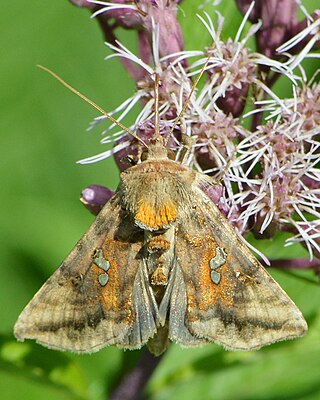
Autographa bimaculata, the two-spotted looper moth, twin gold spot or double-spotted spangle, is a moth of the family Noctuidae. The species was first described by James Francis Stephens in 1830. It is found in North America from Newfoundland west, just short of the coast of British Columbia, north to the Northwest Territories and south to New Mexico in the west and Pennsylvania and Long Island in the east.
Autographa flagellum, the silver whip, is a moth of the family Noctuidae. The species was first described by Francis Walker in 1858. It is found in North America from Newfoundland west across southern Canada to south-eastern British Columbia, south in the east to Maine, Michigan and Wisconsin. There are isolated reports from further south.
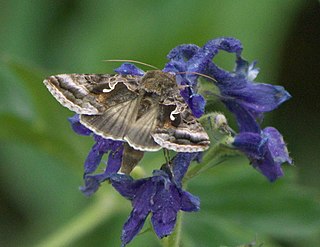
Autographa pseudogamma, the delicate silver Y, is a moth of the family Noctuidae. The species was first described by Augustus Radcliffe Grote in 1875. It is found in North America from Newfoundland to coastal northern Alaska, south in the east to New England and in the western mountains to New Mexico, Arizona and California. It is also found in the Cypress Hills and the Black Hills of South Dakota.

Schinia jaguarina, the jaguar flower moth, is a moth of the family Noctuidae. The species was first described by Achille Guenée in 1852. It is found on North America's Great Plains from Saskatchewan and Alberta south to Texas, eastward on coast to Florida and westward in south to Arizona. In Mexico it is found down to Mexico City.
Rhizagrotis stylata is a moth of the family Noctuidae first described by John Bernhardt Smith in 1893. It is found in North America from south-eastern Alberta south to at least Arizona.
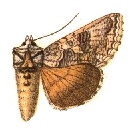
Syngrapha selecta, the chosen looper moth, is a moth of the family Noctuidae. The species was first described by Francis Walker in 1858. It is found in North America from the Northwest Territories to Newfoundland south to northern Michigan.

Syngrapha epigaea, the pirate looper moth or narrow silver Y, is a moth of the family Noctuidae. The species was first described by Augustus Radcliffe Grote in 1874. It is found from coast to coast in Canada south in the east to Pennsylvania, Ohio, and the northern Great Lakes states.
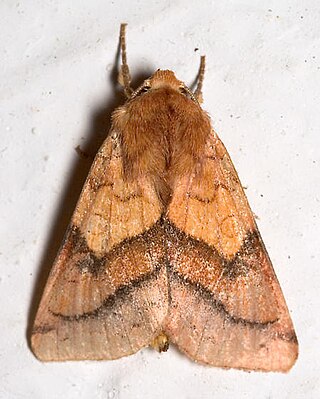
Pyrrhia exprimens, the purple-lined sallow, is a moth of the family Noctuidae. The species was first described by Francis Walker (entomologist) in 1857. In North America it is found from Newfoundland and Labrador west across southern Canada to southern Vancouver Island, south to Texas, Arizona and California. Outside of North America it is found in Finland, the West Siberian plain, the South Siberian Mountains and Kazakhstan.

Euxoa adumbrata, the sordid dart, is a moth of the family Noctuidae. The species was first described by Eduard Friedrich Eversmann in 1842. In North America it is found across northern Canada from Quebec to western Alaska, south to the northern parts of the United States, and in the mountains to Colorado. It is also found in Greenland, the coastal areas of Scandinavia and the Ural. It was recently recorded from Denmark, although this includes Euxoa lidia, which some authors regard to be a valid species.
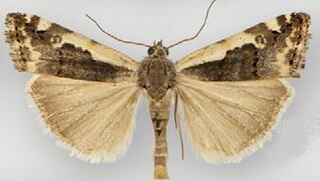
Tarache augustipennis, the narrow-winged midget, is a moth of the family Noctuidae. The species was first described by Augustus Radcliffe Grote in 1875. It is found in North America from Manitoba to south-western British Columbia, south to Arizona and east to Texas.

Alypia mariposa, the mariposa forester, is a moth of the family Noctuidae. The species was first described by Augustus Radcliffe Grote and Coleman Townsend Robinson in 1868. It is found in Coast Ranges and Sierra foothills of California, from Kern and San Luis Obispo counties in the south to Placer County in the north.
















